
Small mammals of Yellowstone National Park
Encyclopedia
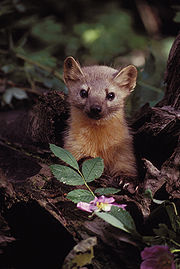
Yellowstone National Park
Yellowstone National Park, established by the U.S. Congress and signed into law by President Ulysses S. Grant on March 1, 1872, is a national park located primarily in the U.S. state of Wyoming, although it also extends into Montana and Idaho...
.
Species are listed by common name, scientific name, typical habitat and relative abundance.
Raccoons
Order: CarnivoraCarnivora
The diverse order Carnivora |Latin]] carō "flesh", + vorāre "to devour") includes over 260 species of placental mammals. Its members are formally referred to as carnivorans, while the word "carnivore" can refer to any meat-eating animal...
Family: Procyonidae
Procyonidae
Procyonidae is a New World family of the order Carnivora. It includes the raccoons, coatis, kinkajous, olingos, ringtails and cacomistles. Procyonids inhabit a wide range of environments, and are generally omnivorous.-Characteristics:...
- RaccoonRaccoonProcyon is a genus of nocturnal mammals, comprising three species commonly known as raccoons, in the family Procyonidae. The most familiar species, the common raccoon , is often known simply as "the" raccoon, as the two other raccoon species in the genus are native only to the tropics and are...
, Procyon lotor, rivers, cottonwoods, rare
Badgers and Weasels
Order: CarnivoraCarnivora
The diverse order Carnivora |Latin]] carō "flesh", + vorāre "to devour") includes over 260 species of placental mammals. Its members are formally referred to as carnivorans, while the word "carnivore" can refer to any meat-eating animal...
Family: Mustelidae
Mustelidae
Mustelidae , commonly referred to as the weasel family, are a family of carnivorous mammals. Mustelids are diverse and the largest family in the order Carnivora, at least partly because in the past it has been a catch-all category for many early or poorly differentiated taxa...
- American BadgerAmerican BadgerThe American badger is a North American badger, somewhat similar in appearance to the European badger. It is found in the western and central United States, northern Mexico and central Canada, as well as in certain areas of southwestern British Columbia.Their habitat is typified by open...
, Taxidea taxus, sagebrush, common - FisherFisher (animal)The fisher is a medium-size mammal native to North America. It is a member of the mustelid family, commonly referred to as the weasel family. The fisher is closely related to but larger than the American Marten...
, Martes pennanti, forests, rare, if present - American MartenAmerican MartenThe American marten is a North American member of the family Mustelidae, sometimes referred to as the pine marten. The name "pine marten" is derived from the common but distinct Eurasian species of Martes...
, Martes americana, coniferous forests, common - American MinkAmerican MinkThe American mink is a semi-aquatic species of Mustelid native to North America, though human intervention has expanded its range to many parts of Europe and South America. Because of this, it is classed as Least Concern by the IUCN. Since the extinction of the sea mink, the American mink is the...
, Neovison vison, riparian forests, occasional - North American River Otter, Lontra canadensis, rivers, lakes, ponds, common
- Long-tailed WeaselLong-tailed WeaselThe long-tailed weasel , also known as the bridled weasel or big stoat is a species of mustelid distributed from southern Canada throughout all the United States and Mexico, southward through all of Central America and into northern South America.-Evolution:The long-tailed weasel is the product of...
, Mustela frenata, willows to spruce/fir forests, common - Short-tailed Weasel, Mustela erminea, willows to spruce/fir forests, common
- WolverineWolverineThe wolverine, pronounced , Gulo gulo , also referred to as glutton, carcajou, skunk bear, or quickhatch, is the largest land-dwelling species of the family Mustelidae . It is a stocky and muscular carnivore, more closely resembling a small bear than other mustelids...
, Gulo gulo, alpine, coniferous forests, rare
Skunks
Order: CarnivoraCarnivora
The diverse order Carnivora |Latin]] carō "flesh", + vorāre "to devour") includes over 260 species of placental mammals. Its members are formally referred to as carnivorans, while the word "carnivore" can refer to any meat-eating animal...
Family: Mephitidae
Skunk
Skunks are mammals best known for their ability to secrete a liquid with a strong, foul odor. General appearance varies from species to species, from black-and-white to brown or cream colored. Skunks belong to the family Mephitidae and to the order Carnivora...
- Striped SkunkStriped SkunkThe striped skunk, Mephitis mephitis, is an omnivorous mammal of the skunk family Mephitidae. Found over most of the North American continent north of Mexico, it is one of the best-known mammals in Canada and the United States.-Description:...
, Mephitis mephitis, riparian to forest, rare
Hares and Rabbits
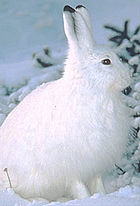
Lagomorpha
The lagomorphs are the members of the taxonomic order Lagomorpha, of which there are two living families, the Leporidae , and the Ochotonidae...
Family: Leporidae
Leporidae
Leporids are the approximately 50 species of rabbits and hares which form the family Leporidae. The leporids, together with the pikas, constitute the mammalian order Lagomorpha. Leporids differ from pikas in having short furry tails, and elongated ears and hind legs...
- Snowshoe HareSnowshoe HareThe Snowshoe Hare , also called the Varying Hare, or Snowshoe Rabbit, is a species of hare found in North America. It has the name "snowshoe" because of the large size of its hind feet and the marks its tail leaves. The animal's feet prevent it from sinking into the snow when it hops and walks...
, Lepus americanus, forests, willows, common - White-tailed JackrabbitWhite-tailed JackrabbitThe White-tailed Jackrabbit , also known as the Prairie Hare and the White Jack, is a hare found in western North America. Briefly reputed to have been extirpated , it is now clear from observations, roadkilled specimens and historical records that white-tailed jackrabbits are still extant in...
, Lepus townsendii, sagebrush, grasslands, common - Desert CottontailDesert CottontailThe Desert Cottontail , also known as Audubon's Cottontail, is a New World cottontail rabbit, a member of the family Leporidae....
, Sylvilagus audubonii, shrub lands, common - Mountain CottontailMountain CottontailThe Mountain Cottontail or Nuttall's Cottontail is a species of mammal in the Leporidae family. It is found in Canada and the United States.- Description :...
, Sylvilagus nuttallii, shrub lands, common
Pikas
Order: LagomorphaLagomorpha
The lagomorphs are the members of the taxonomic order Lagomorpha, of which there are two living families, the Leporidae , and the Ochotonidae...
Family: Ochotonidae
- American PikaAmerican PikaThe American pika , a diurnal species of pika, is found in the mountains of western North America, usually in boulder fields at or above the tree line. They are herbivorous, smaller relatives of rabbits and hares.-Description:...
, Ochotona princeps, rocky slopes, common
Shrews
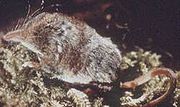
Soricomorpha
The order Soricomorpha is taxon within the class of mammals. In previous years it formed a significant group within the former order Insectivora...
Family: Soricidae
- Dusky ShrewMontane ShrewThe Montane Shrew is a species of mammal in the Soricidae family. It is found in Alaska, western Canada, the western United States and Mexico....
, Sorex monticolus , moist meadows, forests, common - Masked ShrewMasked ShrewThe Cinereus Shrew or Masked Shrew is a small shrew found in Alaska, Canada and the northern United States. This is the most widely distributed shrew in North America where it is also known as the Common Shrew.- Description :...
, Sorex cinereus, moist meadows, forests, common - American Water ShrewAmerican Water ShrewThe American Water Shrew or Northern Water Shrew, is a large North American shrew found in aquatic habitats. Some sources include the Glacier Bay Water Shrew, S. alaskanus, within this species....
, Sorex palustris, moist meadows, forests, common - Preble's ShrewPreble's ShrewPreble's Shrew is a species of mammal in the family Soricidae. It is endemic to southern British Columbia in Canada and the western United States....
, Sorex preblei, moist meadows, forests, rare, if present - Dwarf ShrewDwarf ShrewThe Dwarf Shrew is a species of mammal in the family Soricidae. It is endemic to Arizona, Colorado, Montana, Nebraska, New Mexico, South Dakota, Utah and Wyoming in the United States....
, Sorex nanus, moist meadows, forests, rare
Beaver
Order: RodentRodent
Rodentia is an order of mammals also known as rodents, characterised by two continuously growing incisors in the upper and lower jaws which must be kept short by gnawing....
ia
Family: Castoridae
Castoridae
The family Castoridae contains the two living species of beaver and their fossil relatives. This was once a highly diverse group of rodents, but is now restricted to a single genus, Castor.- Characteristics :...
- Beaver, Castor canadensis, ponds, streams, approximately 500
Squirrels
Order: RodentRodent
Rodentia is an order of mammals also known as rodents, characterised by two continuously growing incisors in the upper and lower jaws which must be kept short by gnawing....
ia
Family: Sciuridae
- Least ChipmunkLeast ChipmunkThe least chipmunk is the smallest chipmunk in North America. It is also the most widespread species of chipmunk in North America occurring across north-central and western United States and from British Columbia and southern Yukon to western Quebec in Canada...
, Tamias minimus, forests, common - Uinta ChipmunkUinta ChipmunkThe Uinta chipmunk, Neotamias umbrinus, is a species of Chipmunk, a rodent in the family Sciuridae. It is endemic to the United States.-Habitat:...
, Tamias umbrinus, forests, common - Yellow-pine ChipmunkYellow-pine ChipmunkThe yellow-pine chipmunk is a species of rodent in the Sciuridae family. It is found in Canada and the United States....
, Tamias amoenus, forests, common - Yellow-bellied MarmotYellow-bellied MarmotThe yellow-bellied marmot , also known as the rock chuck, is a ground squirrel in the marmot genus.-Description:...
, Marmota flaviventris, rocky slopes, common - Golden-mantled Ground SquirrelGolden-mantled Ground SquirrelThe golden-mantled ground squirrel, Callospermophilus lateralis, is a type of ground squirrel found in mountainous areas of western North America. It eats seeds, nuts, berries, insects, and underground fungi. It is preyed upon by hawks, jays, weasels, foxes, bobcats, and coyotes. A typical adult...
, Callospermophilus lateralis, forests, rocky slopes, common - Northern Flying SquirrelNorthern Flying SquirrelThe Northern flying squirrel is one of two species of the genus Glaucomys, the only flying squirrels found in North America . Unlike most members of their family, flying squirrels are strictly nocturnal...
, Glaucomys sabrinus, forests, occasional - American Red SquirrelAmerican Red SquirrelThe American Red Squirrel is one of three species of tree squirrel currently classified in the genus Tamiasciurus and known as pine squirrels...
, Tamiasciurus hudsonicus, forests, common - Uinta Ground SquirrelUinta Ground SquirrelThe Uinta ground squirrel , commonly called a Potgut in northern Utah, is a native of the northern Rocky Mountains and surrounding foothills of the United States including Idaho, Montana, Utah, and Wyoming...
, Urocitellus armatus, sagebrush, meadows, common
Pocket Gophers
Order: RodentRodent
Rodentia is an order of mammals also known as rodents, characterised by two continuously growing incisors in the upper and lower jaws which must be kept short by gnawing....
ia
Family: Geomyidae
- Northern Pocket GopherNorthern Pocket GopherThe Northern Pocket Gopher, Thomomys talpoides, was first discovered by Lewis and Clark on April 9, 1805 at the mouth of the Knife River, North Dakota. These animals are often rich brown or yellowish brown, but also grayish or closely approaching local soil color and have white markings under chin...
, Thomomys talpoides, sagebrush, meadows, forests, common
Mice
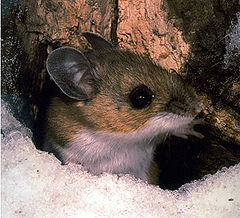
Rodent
Rodentia is an order of mammals also known as rodents, characterised by two continuously growing incisors in the upper and lower jaws which must be kept short by gnawing....
ia
Family: Cricetidae
Cricetidae
The Cricetidae are a family of rodents in the large and complex superfamily Muroidea. It includes true hamsters, voles, lemmings, and New World rats and mice...
- Deer Mouse, Peromyscus maniculatus, grasslands, common
Jumping Mice
Order: RodentRodent
Rodentia is an order of mammals also known as rodents, characterised by two continuously growing incisors in the upper and lower jaws which must be kept short by gnawing....
ia
Family: Dipodidae
Dipodidae
The Dipodidae, or dipodids, are a family of rodents found across the northern hemisphere. This family includes over 50 species among the 16 genera....
- Western Jumping MouseWestern Jumping MouseThe Western Jumping Mouse , is a species of rodent in the Dipodidae family. It is found in Canada and the United States....
, Zapus princeps, riparian, occasional
Muskrats, Voles and Woodrats
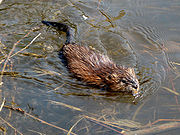
Rodent
Rodentia is an order of mammals also known as rodents, characterised by two continuously growing incisors in the upper and lower jaws which must be kept short by gnawing....
ia
Family: Cricetidae
Cricetidae
The Cricetidae are a family of rodents in the large and complex superfamily Muroidea. It includes true hamsters, voles, lemmings, and New World rats and mice...
- MuskratMuskratThe muskrat , the only species in genus Ondatra, is a medium-sized semi-aquatic rodent native to North America, and introduced in parts of Europe, Asia, and South America. The muskrat is found in wetlands and is a very successful animal over a wide range of climates and habitats...
, Ondatra zibethicus, streams, lakes, ponds, common - Western Heather VoleWestern Heather VoleThe Western Heather Vole, Phenacomys intermedius, is a small vole found in western North America. Until recently, the Eastern Heather Vole, Phenacomys ungava, was considered to be a subspecies....
, Phenacomys intermedius, sagebrush to forests, occasional - Long-tailed VoleLong-tailed VoleThe Long-tailed Vole is a small vole found in western North America. The Coronation Island Vole, once considered to be a separate species, is now believed to be a subspecies....
, Microtus longicaudus, moist meadows, common - Meadow VoleMeadow VoleThe Meadow Vole , sometimes called the Field Mouse or Meadow Mouse, is a North American vole found across Canada, Alaska and the northern United States. Its range extends further south along the Atlantic coast. One subspecies, the Florida Salt Marsh Vole , is found in Florida, and is classified as...
, Microtus pennsylvanicus, moist meadows, common - Montane VoleMontane VoleThe Montane Vole is a species of rodent in the family Cricetidae.It is found in the western United States and British Columbia in Canada.-References:...
, Microtus montanus, moist meadows, common - Southern Red-backed VoleSouthern Red-backed VoleThe Southern Red-backed Vole or Gapper's Red-backed Vole is a small slender vole found in Canada and the northern United States...
, Myodes gapperi, dense forests, common - Water VoleWater Vole (North America)The Water Vole, Microtus richardsoni, is the largest North American vole. It is found in the northwestern United States and southern parts of western Canada...
, Microtus richardsoni, riparian, occasional - Bushy-tailed WoodratBushy-tailed WoodratThe Bushy-tailed Woodrat, Packrat, or Woodrat is a species of rodent in the family Cricetidae.It is found in Canada and the United States....
, Neotoma cinerea, rocky slopes, common
Porcupines
Order: RodentRodent
Rodentia is an order of mammals also known as rodents, characterised by two continuously growing incisors in the upper and lower jaws which must be kept short by gnawing....
ia
Family: Erethizontidae
- North American PorcupineNorth American PorcupineThe North American Porcupine , also known as Canadian Porcupine or Common Porcupine, is a large rodent in the New World porcupine family. The Beaver is the only rodent larger than the North American Porcupine found in North America...
, Erethizon dorsatum, forests, sagebrush, willows, common
Bats
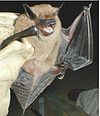
Family: Vespertilionidae
- Big Brown BatBig brown batThe Big Brown Bat is larger in size than comparative species of bats, from about 4 to 5 inches in body length, with a 11-13 inch wingspan and weighing 1/2 to 5/8 ounce. The fur is moderately long, and shiny brown...
, Eptesicus fuscus, roost in sheltered areas, common - Fringe-tailed bat, Myotis thysanodes, roost in cliffs, large snags, uncommon
- Hoary BatHoary batThe hoary bat is a species of bat in the vesper bat family, Vespertilionidae. It occurs throughout most of North America and much of South America, with disjunct populations in the Galapagos and Hawaiian Islands...
, Lasiurus cinereus, roost in trees. uncommon - Little Brown BatLittle brown batThe little brown bat is a species of the genus Myotis , one of the most common bats of North America...
, Myotis lucifugus, roost in caves, buildings, trees, common - Long-eared BatLong-eared MyotisThe Long-eared Myotis is a species of vesper bat. It can be found in western Canada, the western United States, and Baja California in Mexico....
, Myotis evotis, roost in cliffs, buildings, uncommon - Long-legged BatLong-legged MyotisThe Long-Legged Myotis is a species of vesper bat in the Vespertilionidae family.It can be found in Alberta and British Columbia in Canada, Mexico, and the western United States....
, Myotis volans, roost in tree cavities, cliffs, buildings, common - Silver-haired batSilver-Haired BatThe Silver-haired Bat is a species of vesper bat in the family Vespertilionidae and the only member of the genus Lasionycteris.- Habitat :...
, Lasionycteris noctivagans, roost in trees, including snags, common - Western small-footed BatWestern Small-footed MyotisThe Western Small-Footed Bat , also known as the Western Small-Footed Myotis, is a species of vesper bat in the Vespertilionidae family.It can be found in Canada, Mexico, and the United States....
, Myotis ciliolabrum, roost in rocky areas, caves, rare, if present - Townsend's Big-eared BatTownsend's big-eared batTownsend's Big-Eared Bat is a species of vesper bat in the Vespertilionidae family.- Description :The Townsend's Big-Eared Bat is a medium-sized bat with extremely long, flexible ears and small yet noticeable lumps on each side of the snout. Its upperparts are similar to dark brown on the back,...
, Corynorhinus townsendii), roost in caves, uncommon - Yuma BatYuma MyotisThe Yuma Myotis is a species of vesper bat in the Vespertilionidae family. Yuma Myotis occur in a variety of western lowland habitats where it forages for insects just above the surface of slow moving water. It eats a variety of soft-bodied insects, primarily moths. It is found in British Columbia...
, Myotis yumanensis, roost in caves, buildings, trees. rare, if present

